New Light on Adult Literacy and Numeracy in Scotland: Evidence from the 2004 survey of the 1970 British Cohort Study (BCS70)
This report gives the results of a separate analysis for Scotland of literacy and numeracy data collected in the 1970 British Cohort Study at age 34. It relates performance in these skills to a wide range of other features of Scottish cohort members' lives.
Chapter 7 Working life and economic disadvantage
We take a step back now and look at the first moves cohort members made to independence and taking on adult responsibilities. In this Chapter we look at first employment up to current situation at age 34 including work-related and other associated financial disadvantages. In Chapter 8 we turn to age of first leaving the parental home and experiences in the housing market up to age 34 including a look at the local environment and community participation, and finally in Chapter 9 we describe relationship formation, becoming a parent and health and well-being.
Age of first job
In line with an early exit from education, Figure 7.1 shows that more men with SCQF Level 4 or below literacy and numeracy entered the labour market at age 16 or 17. For women, those with SCQF Access Level literacy or SCQF Access Level 2 numeracy were also the most likely to have their first job after leaving school when they were still 16. Entrance to the workforce at age 16 was lowest for men and women with SCQF Level 5 numeracy - 25% men and 20% women.
Figure 7.1: age men and women entered workforce by literacy or numeracy
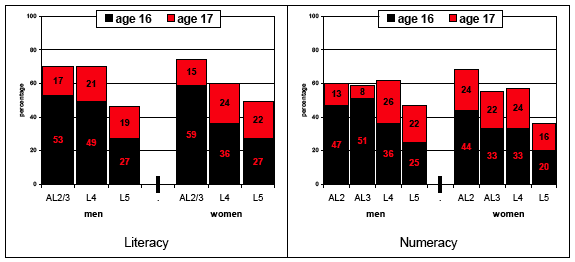
Working Life
Between April 1986, when cohort members turned 16 and could leave full-time education, and March 2004, the month before their 34 th birthday, there were 18 years of possible economic activity. We first look at the proportion of time men and women have spent in each 'status' such as full-time paid employment, full-time home-care role, education, training, unemployment, etc, during this time. We also chart the percentage of men and women in full-time employment in each year between age 16 and 34, highlighting the different experiences of the men and women with Access Level skills.
Men: employment between age 16 to 34
Figure 7.2 shows that although men in each skills group have spent a similar proportion of their working life to date in full-time employment (between 74-79%), when not in full-time employment men with SCQF Access Level 2 or 3 literacy or SCQF Access Level 2 numeracy were most likely to have been unemployed, on a government training course or sick, whereas men with SCQF Level 5 skills were in full-time education. Compared with men with SCQF Level 5 skills, men with SCQF Access Level 2 numeracy have, on average, spent nearly four times as long in unemployment (19 months to 5 months) and men with SCQF Access Level 2 or 3 literacy three times as long (18 months to 6 months). The less stable working experiences of men with SCQF Access Level 2 or 3 literacy and SCQF Access Level 2 numeracy is further illustrated when we looked at the number of different episodes of unemployment men had suffered during their working life. Here differences were greatest across numeracy groups: 19% of men with SCQF Access Level 2 numeracy had been unemployed on 3+ occasions compared with 10% of men with SCQF Access Level 3 numeracy, 8% of men with SCQF Level 4 numeracy and 4% of men with SCQF Level 5 or higher numeracy. Just 45% of men with SCQF Access Level 2 numeracy had never been unemployed, compared with 73% of men with SCQF Level 5 or higher numeracy.
When we restrict the comparison to early school leavers - those who had left full-time education at age 16 - we find that men with SCQF Access Level literacy or numeracy have spent the least time in full-time employment, but still the most time unemployed. In terms of years and months, men with SCQF Level 5 literacy have spent an additional one and a half years in full-time employment compared to men with SCQF Access Level 2 or 3 literacy or SCQF Access Level 2 numeracy (15 years 10 months to 14 years 4 months by literacy; 16 years to 14 years 4 months by numeracy). Differences in time spent unemployed among early school leavers are as wide between skills groups as when we looked at all men - regardless of their age when they left full-time education. The same is true for differences in the number of separate spells of unemployment. What this shows is that even with an increased exposure to the risk of unemployment and not having the higher level qualifications that extended time in education will have undoubtedly brought, men with SCQF Level 5 skills who left school at age 16 are no more likely to experience unemployment than those who left later on.
Figure 7.3 gives the percentage of men in each skills group who have spent the most time in each year in full-time employment 29. These graphs clearly show that once men with SCQF Level 5 skills have largely finished with full-time education in their early-mid twenties, they consistently have the highest levels of full-time employment. Among literacy groups, it is only men with SCQF Level 5 skills that have a notably higher level of engagement in full-time work in each year. By numeracy, percentages in full-time employment in each year are also notably higher for men with SCQF Level 4 skills, though levels of engagement for men with SCQF Level 5 skills are higher again.
Figure 7.2 proportion of time men spent in each economic status between April 1986 (age 16) up to March 2004 (age 33) by literacy and numeracy
a) All men
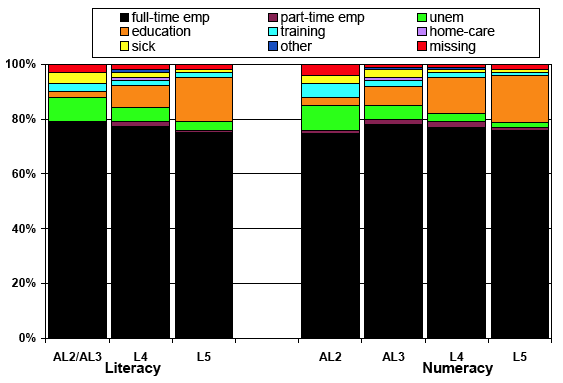
b) Early school leavers
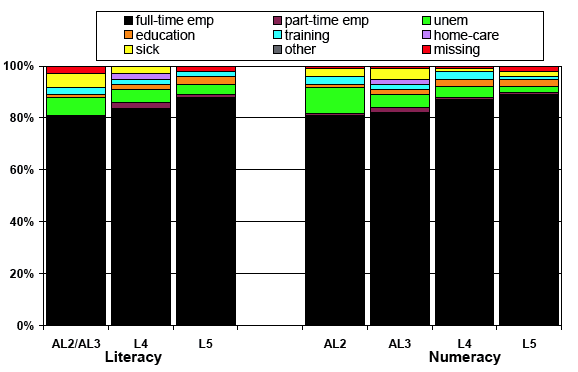
Figure 7.3 % men in full-time employmentfrom April 1986 (age 16) up to March 2004 (age 33)
a) literacy
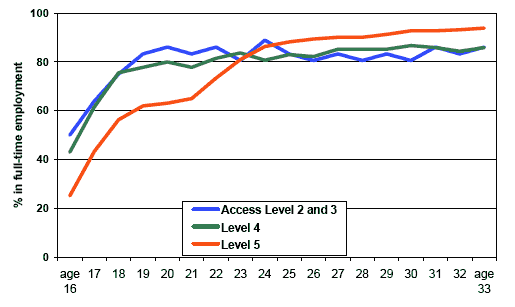
b) numeracy
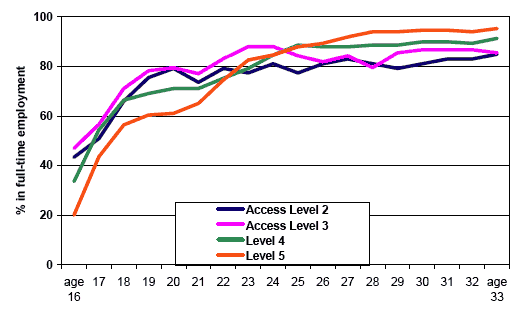
Men: current employment and occupation at age 34
Unsurprisingly, men with SCQF Access Level literacy or numeracy were the least likely to be in full-time work at age 34, and the most likely to be unemployed or sick. Among those working at the time of interview in 2004, the very different occupation profiles of men with SCQF Access Level skills was very apparent. Figure 7.4 shows that 4 in 10 men with SCQF Access Level 2 or 3 numeracy skills worked as a Plant or Machine operative. 2 in 10 worked in the unskilled, insecure and more unregulated jobs that were classified under 'Other' occupations - four times as many as men with SCQF Level 5 literacy. Although 7% worked as a Manager or an Administrator, this was around three times more likely among men with SCQF Level 5 or higher skills. The exclusion of men with SCQF Access Level skills from the modern service sector office based jobs that increasingly make up today's job opportunities was clearly highlighted when asked if they used a computer at work. Figure 7.5 shows that just 38% of men with SCQF Access Level 2 or 3 literacy and 46% of men with SCQF Access Level 2 numeracy used a PC at work compared with three-quarters of men with SCQF Level 5 skills (75% literacy, 78% numeracy). Men with SCQF Access Level 2 or 3 literacy and SCQF Access Level 2 numeracy were also far less likely to have been promoted whist in their current position (25% to 55% literacy, 33% to 55% numeracy), or to have received work related training. Men with SCQF Level 5 numeracy were the most likely to have been on at least one work-related training course (42% to 19% SCQF Access Level 2 numeracy).
Figure 7.4 Current occupation at age 34 for men by grasp of literacy and numeracy
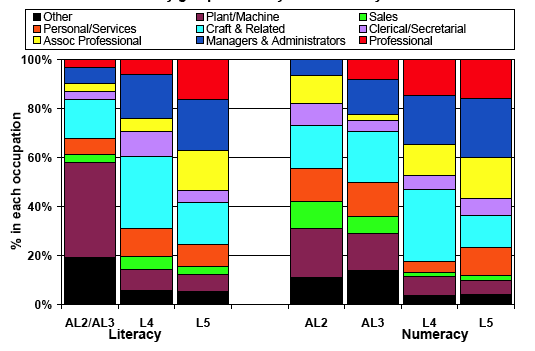
Figure 7.5: Men: numeracy, literacy, full-time work, PC use, work-related training and promotion
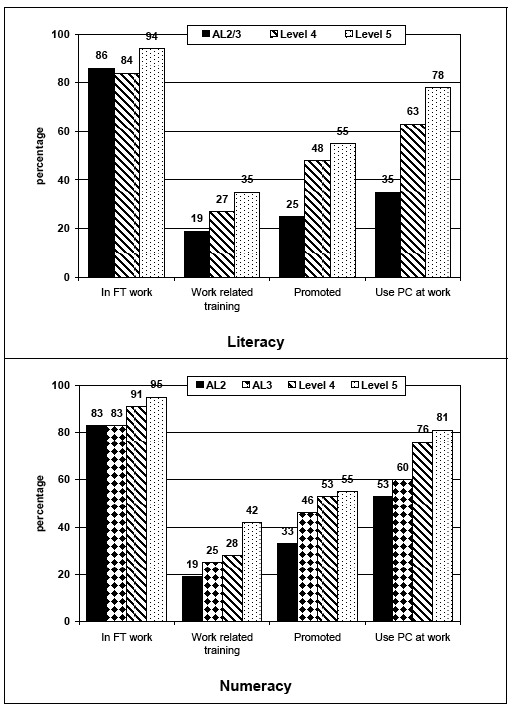
Women: employment between age 16 to 34
As we might expect, women with SCQF Access Level literacy skills have spent less time in full-time employment - or indeed any paid employment - between age 16 and 34 than women with SCQF Level 4 or higher skills. Differences in amount of time spent in full-time or part-time employment were not so apparent between numeracy groups. Figure 7.6 shows that when not in paid employment, women with SCQF Level 5 skills were largely engaged in full-time education whereas women with SCQF Access Level 2 or 3 literacy were predominantly looking after their children in a full-time home-care role. To minimise the education effect, we again restricted our look to women who had all left full-time education by age 16. Differences between groups persisted. Women with SCQF Level 5 skills who had left school early had spent around 14 of the available 18 years in paid employment (13 years 11 months literacy, 14 years 2 months numeracy) compared with 10 years by women with SCQF Access Level 2 or 3 literacy and 10 years 9 months by women with SCQF Access Level 2 numeracy. Although much of their time was spent in a full-time home-care role, women with SCQF Access Level 2 or 3 literacy had been unemployed for more than four times as long as women with SCQF Level 5 literacy (18 months compared with 4 months). Compared with women with SCQF Level 5 numeracy, women with SCQF Access Level 2 numeracy had spent more than twice as long unemployed (13 months against 5 months) and three times as long in a home care role (4 years 4 months against 1 year 3 months). Reflecting their more disjointed employment trajectories, women with SCQF Access Level 2 or 3 literacy and SCQF Access Level 2 numeracy were twice as likely to have experienced 2+ separate spells of unemployment, compared with women with SCQF Level 5 or higher skills (12% to 6%).
As for men, we also chart the percentage of women who spent the best part of each year in paid employment. In Figure 7.7 we chart full-time employment and in Figure 7.8 full-time employment in combination with part-time employment. Differences in full-time employment between literacy groups are very stark, remaining so even when part-time employment was included. No more than 1 in 2 women (around 50%) with SCQF Access Level 2 or 3 literacy were engaged in paid employment during their mid-late twenties, though this did increase to just below 60% when they reached their thirties. This suggests that women with SCQF Access Level skills were less likely to have combined child-care with part-time employment, though whether this was due to their restricted employment opportunities with poor economic returns or just simply that they wanted to be a full-time mum is not known. Conversely, when we combined part-time with full-time employment for women with SCQF Level 5 literacy, the percentage in paid employment in each year was comparable with those of men. Combining part-time with full-time employment increased levels of engagement in all numeracy groups, though women with SCQF Access Level 2 skills still had the lowest levels in paid employment in each year from their early twenties when more and more women begin to exit the labour market to have children. Unlike for literacy, the experiences of women with SCQF Level 4 numeracy skills are closer to those of women with SCQF Level 5 skills, with around 85% spending most time in any one year from age 24 in paid employment.
Figure 7.6 Proportion of time women spent in each economic status between April 1986 (age 16) up to March 2004 (age 33) by literacy and numeracy
a) All women
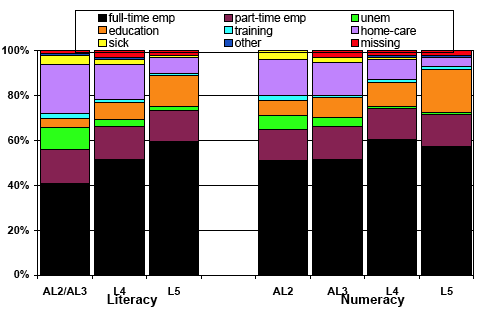
b) Early school leavers
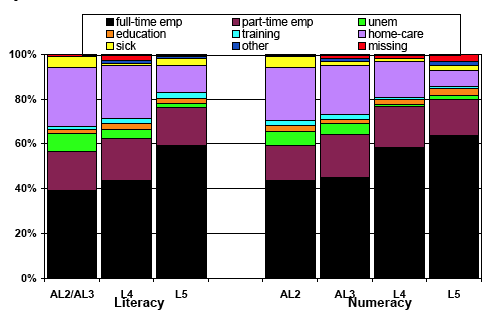
Figure 7.7 % women in full-time employment from April 1986 (age 16) up to March 2004 (age 33)
a) Literacy
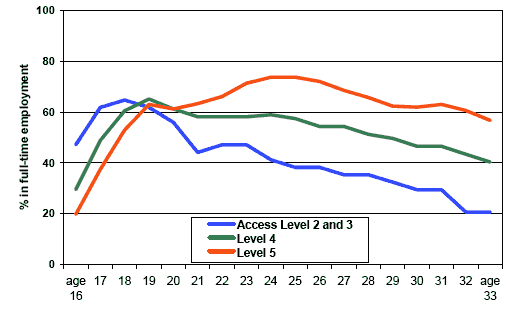
b) Numeracy
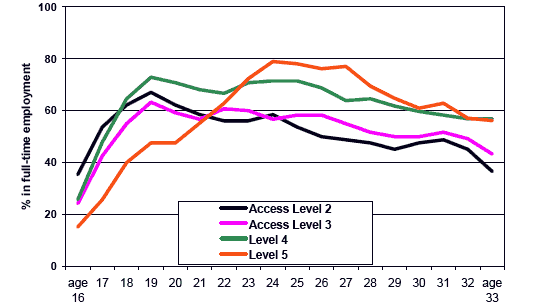
Figure 7.8 % women in full-time or part-time employmentfrom April 1986 (age 16) up to March 2004 (age 33)
a) Literacy
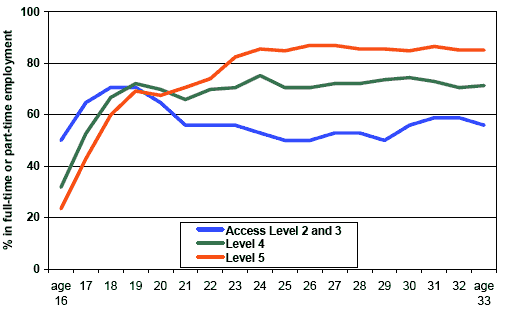
b) Numeracy
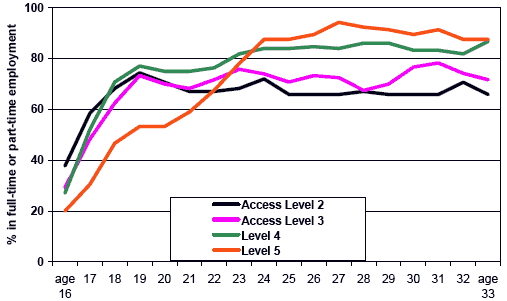
Women: employment and occupation at age 34
Unsurprisingly, women with SCQF Access Level skills were the least likely to be working full-time at age 34 (21% SCQF Access Level 2 or 3 literacy, 35% SCQF Access Level 2 numeracy and more than 50% SCQF Level 5 literacy or numeracy). They were most likely to be in an unpaid 'at home' role (29% SCQF Access Level 2 or 3 literacy, around 18% SCQF Access Level 2 or 3 numeracy, less than 10% SCQF Level 5 literacy or numeracy). Compared with women with SCQF Level 5 skills they were also the most likely to be 'unemployed' (6% to 1% literacy, 5% to 2% numeracy) or temporarily or permanently 'sick' (6% to 2% literacy, 6% to 1% numeracy).
As with men, women with SCQF Access Level 2 or 3 literacy were far more likely than any others to work in the myriad of unskilled insecure jobs classified as 'Other' occupations. In Figure 7.9 the concentration of these women to less skilled jobs in Sales (checkout work), Personal/Service (cleaning) jobs, or traditional 'male' work - as many as 1 in 10 work as Plant/Machine operatives - is clear to see, as is their complete exclusion from the more desired office based Clerical/Secretarial work. At the other end of the skills scale, less than 1 in 4 women with SCQF Level 5 literacy and 1 in 5 with SCQF Level 5 numeracy worked in these more physically demanding jobs. Around half of women with SCQF Level 5 numeracy worked as a Professional or a Manager/Administrator. As for men, the exclusion of women with SCQF Access Level 2 or 3 literacy from work that requires modern up-to-date skills is apparent by the relatively few who needed to use a computer ( PC) at work - 32% compared with 60% of women with SCQF Access Level 2 numeracy and more than 8 in 10 women with SCQF Level 5 skills (81% literacy, 85% numeracy). Figure 7.10 shows that investment by employers in women in terms of training was lower than for men overall, but women with SCQF Access Level 2 or 3 literacy or SCQF Access Level 2 numeracy were the least likely to have been on training course and women with SCQF Level 5 numeracy the most likely. Small numbers restricted looking at promotion among literacy groups, but whereas 29% of women with SCQF Access Level 2 numeracy had been promoted since being in their current job, this increased to 43% for women with SCQF Access Level 3 numeracy and around 1 in 2 for women with SCQF Level 4 or higher numeracy skills (47% Level 4, 50% Level 5).
Figure 7.9 Current occupation at age 34 for women by grasp of literacy and numeracy
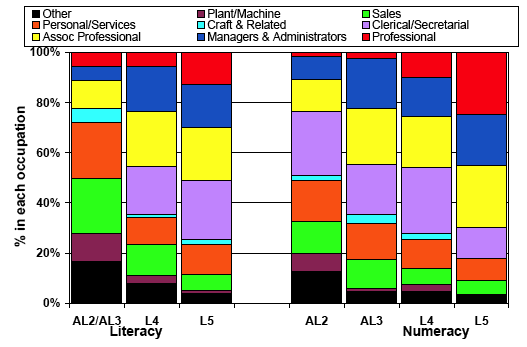
Figure 7.10: Women: literacy, numeracy, full-time or part-time work, PC use, work-related training and promotion
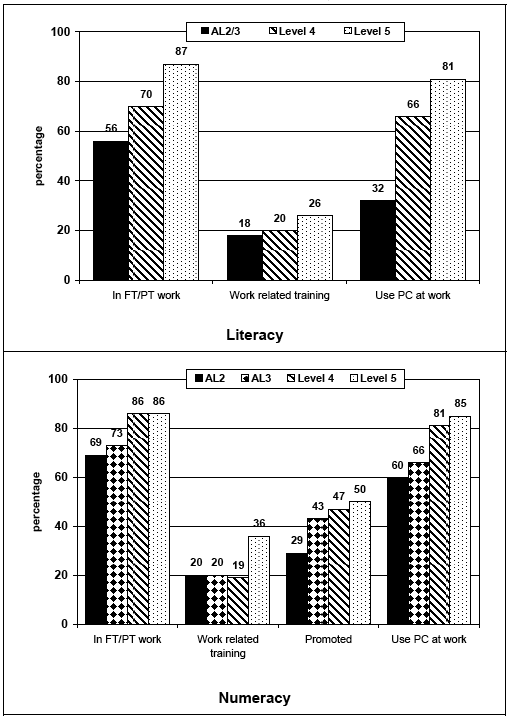
Financial Circumstances
Men and women with the lowest grasp of literacy or numeracy were most likely to be experiencing economic disadvantage, shown through a variety of measures, some of which are illustrated in Figure 7.11. Men and women with SCQF Access Level 2 or 3 Literacy or SCQF Access Level 2 numeracy, or their partner if they had one, were six times more likely than men and women with SCQF Level 5 or higher skills to receive state benefits (e.g., income support, housing benefit, council tax benefit). Men and women with SCQF Access Level 2 or 3 literacy or SCQF Access Level 2 numeracy were less likely, or less able, to make regular savings from their income, and up to three times less likely to have any investments (14% to 38% literacy, 13% to 46% numeracy). They were more than twice as likely as men and women with SCQF Level 5 skills to have borrowed money from a pawnbroker, moneylender, friends or family members (24% to 13% literacy, 23% to 10% numeracy) and, unsurprisingly, fewer reported that they were 'living comfortably' (21% to 40% literacy, 28% to 48% numeracy).
Men and women with SCQF Access Level 2 or 3 literacy or SCQF Access Level 2 numeracy were also the most likely to be part of a non-working household 30, but differences were most apparent for women. 24% of women with SCQF Access Level 2 or 3 literacy and 20% with SCQF Access Level 2 numeracy were part of a non-working household compared with just 4% of women with SCQF Level 5 or higher literacy or numeracy. Men with SCQF Access Level skills were twice as likely as men with SCQF Level 5 skills to be part of a non-working household (11% to 5%).
Looking at differences within Scotland, we again find signs that the disadvantage is compounded for men and women living within the Central Belt. Whereas very little - if any - difference was found between the reported financial situation of men and women with a better grasp of literacy or numeracy, men and women with the lowest literacy tended to be worse off across a number of measures compared to those living in other parts of Scotland. For example, 6% of men and women with SCQF Access Level 2 or 3 literacy had investments within the Central Belt, but this increased to 23% among those living elsewhere. Comparable differences for numeracy were 10% to 18%. Men and women with low skills living outside the Central Belt were also less likely to be part of a non-working household, with differences again being widest between those with SCQF Access Level 2 or 3 literacy, (9% living elsewhere, 26% within the Central Belt).
Figure 7.11: savings, investments, income support, non-working households by grasp of literacy and numeracy at age 34
a) Literacy
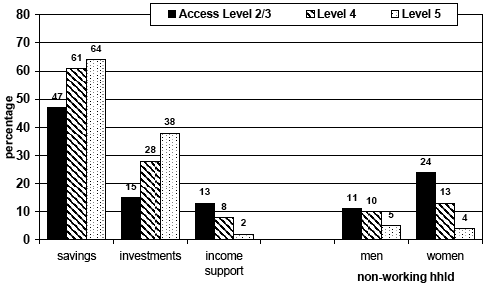
b) Numeracy
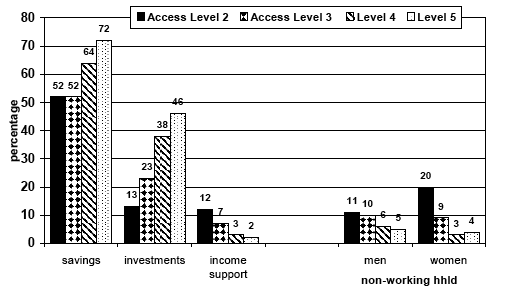
Summary employment and economic disadvantage
Large numbers of men and women with the poorest skills first entered the workforce at 16, but they had spent the least amount of time in full-time or part-time employment over the following eighteen years. Men with SCQF Access Level skills spent more time unemployed or sick, women in a full-time home-care role. At age 34, men and women in work had very different occupational profiles than men and women with a better grasp of literacy and numeracy, being far more likely to be in labour intensive low skilled jobs, often in the less secure unregulated 'Other' parts of the labour market (19% men and 17% women with SCQF Access Level 2 or 3 literacy compared with just 5% men and 4% women with SCQF Level 5 literacy). Lower levels of training (19% men and 20% women with SCQF Access Level 2 numeracy compared with 42% of men and 36% women with SCQF Level 5 numeracy) and promotion (25% men with SCQF Access Level 2 or 3 literacy compared with 55% of men with SCQF Level 5 literacy) show that their disadvantage had been exacerbated by employers being less likely to have invested in these men and women.
Questions about finances revealed the continuation of the (relative) economic disadvantage, or poverty, which has surrounded men and women with SCQF Access Level skills over their lives. Fewer of them reported being able to make regular savings or to have investments (13% SCQF Access Level 2 to 46% SCQF Level 5 numeracy), but more were in receipt of state benefits and part of a non-working household - particularly women with SCQF Access Level 2 or 3 literacy (24% compared with 4% SCQF Level 5 literacy).
There is a problem
Thanks for your feedback